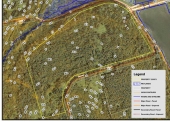





![Filename: 201485895.jpg
Description: [Thumbnail for 201485895.jpg]](/t/66733/a/51340/201485895.jpg)
![Filename: 201485901.jpg
Description: [Thumbnail for 201485901.jpg]](/t/66733/a/51341/201485901.jpg)
 1
1








Cultivate abundance for people, plants and wildlife - Growing with Nature







 And I love your questions.
And I love your questions.  .
.
![Filename: Unknown.jpeg
Description: [Thumbnail for Unknown.jpeg]](/t/66733/a/51353/Unknown.jpeg)








 1
1




Ella Irati wrote:Hi Daron,
What a great deal of work you have done! Will the hedgerow really keep deer from entering? Thats a fantastic analysis you have done.
What I see in America, Canada and Australia, the english speaking countries that post most about permaculture, is that people get to get a bunch of acres with the ability to build a house there! This is not the case in Spain. I have been looking for years and for the most part, a couple of acres that are good for farming will not allow you to build, and if you can build, its so small and expensive that you won´t use large land grow cros.
This is a very traditional area of Europe where the house is in the village and often has a little garden for vegetables across the street, if you are lucky, but many houses don´t have one close by. I happen to have a terrain that is buildable in the village, so zone 1 is 1/3 mile away from zones 2 and beyond.
Zone 1: 1/10 of an acre¡to build a house of about 1300sq feet on, the rest will be path and garden. Walk 1/3 of a mile, find zone 2, 3, 4 and 5. Most locals have to travel much much farther to get to their vegetable gardens and pasture lands.
What do you think? The problem must be the solution, thanks!
Cultivate abundance for people, plants and wildlife - Growing with Nature







When TPTB take away a persons LEGAL ability to produce for themselves, then I will be a criminal and you will get to support me 




Caroline Rodgers wrote:I am NOT an expert,but if I were you........
The first thing I would think about is if your land gets enough water to grow perennial plants without earthworks and if erosion is a current issue.
A close second is: what kind of trees do you want? Also- do you want a very dense food forest or do you want something more like a "savannah" spacing? How many people do you want to feed and how much upkeep can you realistically deal with?
Regardless, I would make a list of all the trees you would want in your perfect world, then start analyzing growth conditions. I would also take soil samples from different regions of your land for analysis. A bit of time and money spent right away can save you a ton of time and money later
Also, I know there was a post about making cheap topographical maps- I would try to check this out.
ETA- super jealous but very excited for you.
 1
1





|
"Ace of Hearts" sounds a little like "Ace o Farts" - says this tiny ad:
The new permaculture playing cards kickstarter is now live!
https://www.kickstarter.com/projects/paulwheaton/garden-cards
|







